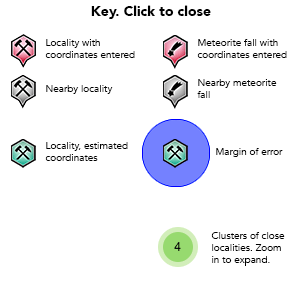Poncha Springs, Chaffee Co., Colorado, USA

| Latitude & Longitude (WGS84): | 38° 30' 48'' North , 106° 4' 35'' West |
|---|---|
| Latitude & Longitude (decimal): | 38.51351,-106.07659 |
| GeoHash: | G#: 9wue45jmk |
| Locality type: | Group of Springs |
| Köppen climate type: | Dfc : Subarctic climate |
Welded tuffs
Mineral List
1 valid mineral.
Regional Geology
This geological map and associated information on rock units at or nearby to the coordinates given for this locality is based on relatively small scale geological maps provided by various national Geological Surveys. This does not necessarily represent the complete geology at this locality but it gives a background for the region in which it is found.
Click on geological units on the map for more information. Click here to view full-screen map on Macrostrat.org
| Late Pleistocene - Middle Pleistocene 0.0117 - 0.781 Ma ID: 2818279 | Gravels and alluviums Age: Pleistocene (0.0117 - 0.781 Ma) Description: Includes Broadway and Louviers Alluviums Lithology: Major:{unconsolidated gravel} Reference: Horton, J.D., C.A. San Juan, and D.B. Stoeser. The State Geologic Map Compilation (SGMC) geodatabase of the conterminous United States. doi: 10.3133/ds1052. U.S. Geological Survey Data Series 1052. [133] |
| Late Pleistocene 0.0117 - 0.126 Ma ID: 3302507 | Outwash gravel of Pinedale glaciation Age: Pleistocene (0.0117 - 0.126 Ma) Description: Glaciofluvial deposits com- posed chiefly of clast-supported, poorly sorted, and crudely stratified, coarse pebble and cobble gravel deposited by glacial meltwater streams during the Pinedale glacia- tion. Unit locally includes layers and lenses of sandy pebble gravel and pebbly sand. Top of gravelly deposits are locally overlain by about 30–50 cm of overbank sediment that is commonly composed of pebbly sand (Nelson and Shroba, 1998). Commonly, deposits proximal to till of Pinedale age (Qtp) are bouldery and locally contain boulders as large as 1.5 m in diameter. Soils formed in unit Qgp have cambic B (Bw) or weakly developed argillic B (Btj and Bt) horizons about 30 cm thick (Nelson and Shroba, 1998). The exposed portions of most surface boulders of granitic composition show little evidence of weathering (Shroba and others, 2014). The sources of unit Qgp are glaciers that deposited till of Pinedale glaciation within and just beyond the mouths of glaciated valleys in the Sawatch Range and Mosquito Range. Gravel along course of Arkansas River commonly consists of Proterozoic granitic and gneissic clasts, a high percentage of Tertiary intrusive rocks, and Paleozoic quartzite. Southeast of the confluence with the South Arkansas River, deposits of unit Qgp along the Arkansas River locally contain large boulders, deposited by glacial-breakout floods during the Pinedale glaciation. These boulders are similar in size and composition to those in units Qpf and Qpfo. Deposits of unit Qgp, in the valley of Lake Creek near the Twin Lakes Reservoir and in the valley of Clear Creek near the Clear Creek Reservoir, are graded to and are coeval with till of unit Qtp, which dates from about 15–22 ka (Young and others, 2011). Unit Qgp along Lake Creek near Balltown locally contains boulders as large as about 2.7×3.0×3.0 m that probably were deposited during one or more glacial outburst floods initiated by the rapid drainage of a lake or lakes impounded by glacial ice or moraines of unit Qtp in the vicinity of the Twin Lakes dam (Shroba and others, 2014). Deposits of unit Qgp locally underlie two or more terrace levels about 2–10 m above South Arkansas River near Maysville and Poncha Springs, the Arkansas River north of Riverside, and the South Fork South Platte River near the eastern boundary of the map area. Estimated thickness is 3–20 m Reference: Kellogg, K.S., R.R. Shroba, C.A. Ruleman, R.G. Bohannon, W.C. McIntosh, W.R. Premo, M.A. Cosca, R.J. Moscati, T.R. Brandt. Geologic map of the upper Arkansas River valley region, north-central Colorado. doi: 10.3133/sim3382. U.S. Geological Survey Scientific Investigations Map 3382. [186] |
| Paleoproterozoic 1600 - 2500 Ma ID: 3192520 | Paleoproterozoic crystalline metamorphic rocks Age: Proterozoic (1600 - 2500 Ma) Lithology: Orthogneiss/paragneiss Reference: Chorlton, L.B. Generalized geology of the world: bedrock domains and major faults in GIS format: a small-scale world geology map with an extended geological attribute database. doi: 10.4095/223767. Geological Survey of Canada, Open File 5529. [154] |
Data and map coding provided by Macrostrat.org, used under Creative Commons Attribution 4.0 License



